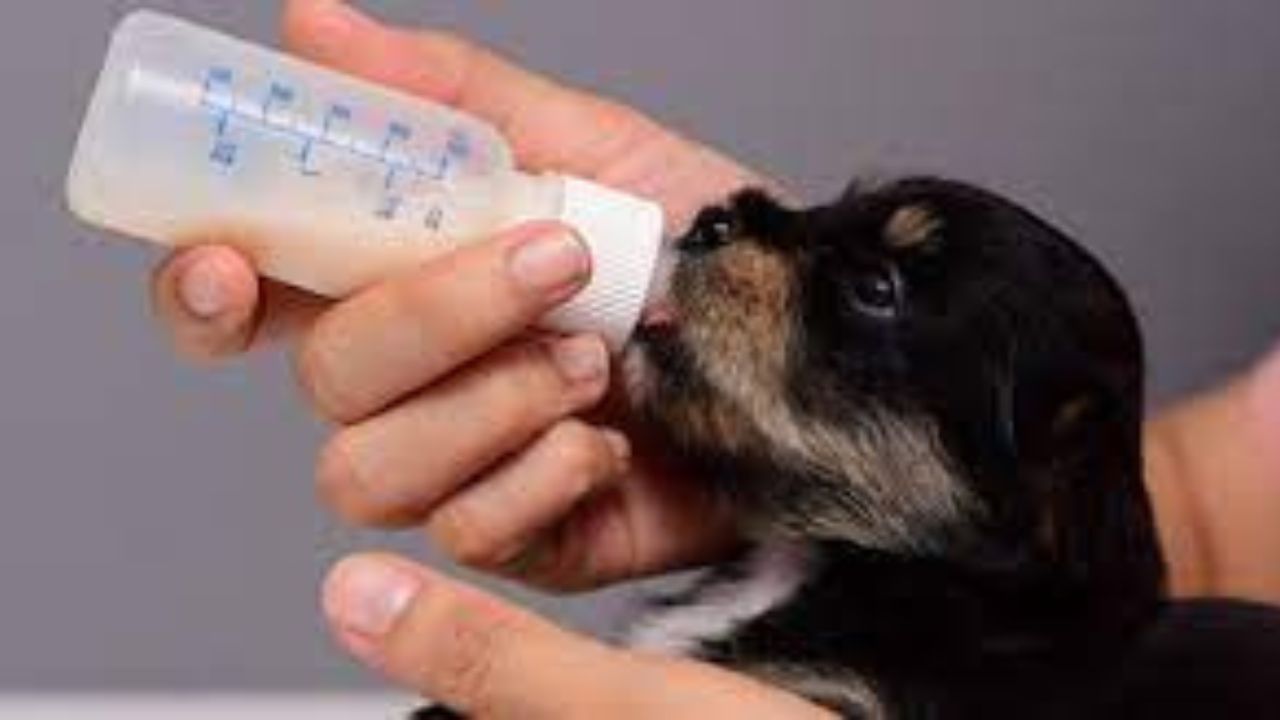A healthy newborn can usually survive chilling if warmed slowly. During the first four days of their life, the orphaned puppy should be kept at an environmental temperature of 29-32°C. When caring for a large litter, the temperature can be slightly lower as puppies huddle together to provide additional warmth.
Caring for newborn puppies without their mother can be a challenging yet rewarding experience. Whether you’re a breeder dealing with unexpected circumstances or a compassionate individual rescuing orphaned pups, providing adequate care is crucial for their survival and well-being. While it requires dedication, patience, and attention to detail, raising newborn puppies successfully without their mother’s presence is feasible.
What should I feed my orphaned puppy?

How To Take Care of Newborn Puppies Without Mother A commercial milk replacer should supply nutrition for newborn orphans until the puppies are about three weeks of age. The puppies are ready to start nibbling moistened solid food at this age. Since newborns may have trouble generating enough heat to maintain their body temperature, the milk replacer should be warmed to 35-37.8°C for the best results.
The milk replacer should be about the same temperature as the skin on your forearm or slightly warmer. The milk replacer can be fed at room temperature as the puppies grow.
Milk formula can be fed either by bottle or tube feeding, where food is directed into the stomach via a feeding tube and syringe. Tube feeding should be discussed with your local veterinarian if your puppies aren’t taking well to a bottle.
Commercial milk replacers have directions on their labels for proper amounts to feed. The puppy’s weight must be obtained properly in ounces or grams. Kitchen scales or postal scales are useful for this purpose. Four meals, equally spaced during 24 hours, are ample for feeding a puppy if the milk replacement is high quality. If the puppy is small or weak, six or more feedings may be necessary.
Setting up a space for newborn puppies
How To Take Care of Newborn Puppies Without Mother If the puppies were being cared for by their mother, she would choose a soft, warm place away from full sunlight. In their mother’s absence, you must provide this type of environment.
A box might be large enough for a first home for the family. Put the box in a warm, sheltered space. If the litter is big, buy a kiddie pool or something similar to contain the pups. As the puppies grow, watch to see whether they can climb out of the box or pool. Once puppies start to move, they can climb well within a surprisingly short period.
Bedding
Use clean packing paper, or newspaper layered on top of a flat towel for bedding for the first week or so. Newborn puppies can get caught up in soft cloth and can die if they can’t breathe. You can use a towel, sheet, or blanket after they lift their heads and move around a bit. When the puppies start crawling and walking, they’ll use the cloth for traction.
Warmth
How To Take Care of Newborn Puppies Without Mother A puppy burns far more body heat per pound of body weight than an adult dog. To stay warm, puppies depend on radiant heat from their mother. In her absence, they need constant temperature control. So, you’ll have to provide your puppies with a draft-free nesting area. Heat lamps or hot water bottles can be used to keep the temperature controlled.
During the first four or five days of life, puppies should be kept in an environment between 85 and 90 degrees Fahrenheit. The temperature can gradually be decreased to 80 degrees by the seventh to 10th day and reduced to 70 to 75 degrees Fahrenheit by the end of the fourth week.
Provide necessary warmth or cooling to the puppies gradually. They will huddle together if you have a large litter so that they won’t require as much help with external heat from you. Take care not to overheat the puppies; newborn puppies cannot move away from the heat on their own.
Bottle-feeding orphaned puppies
How To Take Care of Newborn Puppies Without Mother Newborn puppies will need food every two to three hours around the clock. Six or eight meals, equally spaced over 24 hours, are sufficient for most puppies; small or weak puppies might need more feeding.
You can give your orphaned puppies complete nutrition by buying a commercial puppy milk replacer (such as Esbilac), which can be purchased through your veterinarian or a pet supply store. Commercial milk replacers have feeding directions on the label and should be given at the puppy’s body temperature (about 100 degrees Fahrenheit). Once the can is opened or the powder reconstituted, the unused formula should be kept refrigerated and discarded after 24 hours. When the puppies are 3 to 4 weeks old, you can feed them milk replacer at room temperature.
When feeding orphaned puppies, it’s best to use commercial animal baby bottles; you can use an eyedropper in an emergency, but it does not allow normal sucking as well as a nipple. The size of the hole in the nipple is crucial. If you turn the bottle upside down and the milk drips freely, the hole is too large. The bottle should require a light squeeze (simulating a puppy suckling) for milk to drip. If you need to make the hole bigger, you can heat a needle with a lighter and use it to enlarge the hole.
The Situation
How To Take Care of Newborn Puppies Without Mother The absence of a mother dog raises immediate concerns, as a mother’s care encompasses various vital aspects, including warmth, nourishment, hygiene, and emotional support. To compensate for this absence, you must step in as a surrogate caregiver, replicating these essential elements to ensure the puppies thrive.
Assess the Situation
Upon discovering orphaned puppies, assess their condition promptly. Check for signs of distress, malnutrition, dehydration, or illness. Seek veterinary guidance if needed to address any urgent health concerns.
Create a Warm Environment
Newborn puppies cannot regulate their body temperature, making warmth a priority. Use heating pads or heat lamps to maintain a constant and comfortable temperature, around 85-90°F (29-32°C) for the first week, gradually decreasing by 5°F (2-3°C) each week.
Milk Replacement
Since the mother’s milk provides essential nutrients and antibodies, opt for commercial canine milk replacers available at pet stores or formulated by your vet. Use nursing bottles designed for puppies to feed them every two to four hours, mimicking the natural feeding schedule.
Feeding Techniques
Hold the bottle at an angle to replicate a nursing posture, ensuring the puppies don’t aspirate the milk. Be patient and allow them to feed at their own pace. Avoid overfeeding, as it can lead to digestive issues.
Stimulate Elimination
Like a mother dog, you’ll need to stimulate the puppies to urinate and defecate after each feeding. Use a warm, damp cotton ball or cloth and gently massage their anal and genital areas to encourage elimination.
Maintain Cleanliness
Keep the puppies and their environment clean to prevent infections. Use soft, warm towels or blankets for bedding and change them regularly. Ensure the area remains dry and sanitized.
Consult a Veterinarian
Regular veterinary check-ups are crucial for monitoring the puppies’ health and ensuring they receive appropriate vaccinations, deworming, and medical attention.
Monitor Growth and Development

Keep track of the puppies’ weight, growth, and behaviour. Any abnormalities or deviations from expected developmental milestones should prompt a vet visit.
Provide Emotional Nurturing
While it might be challenging, spend quality time with the puppies, offering gentle handling, cuddling, and social interaction. This helps them feel secure and fosters emotional well-being.
Introduce Social Stimuli
Expose the puppies to sights, sounds, and gentle touches to facilitate proper socialization. This exposure aids in their mental and emotional development.
Introduce Solid Food
Around three to four weeks of age, introduce a gruel of high-quality puppy food mixed with milk replacer. This helps transition them from solely relying on milk to solid food.
Encourage Independence
As the puppies grow, gradually reduce the frequency of bottle feeding and encourage them to explore solid food. Allow them to wean naturally while providing support and guidance.
Conclusion
Raising newborn puppies without their mother demands dedication, patience, and a nurturing touch. You can give these pups a chance at a healthy and fulfilling life by replicating a mother dog’s care and attention. Remember, seeking professional guidance from veterinarians or experienced breeders is invaluable in ensuring the best possible care for these precious beings. With proper care, love, and attention, you can make a significant difference in the lives of orphaned newborn puppies.
FAQ
What do you Feed a Newborn Puppy Without a Mother?
Puppy milk replacers should be the sole source of nutrition until 3-4 weeks of age, when the weaning process may begin. The transition from formula to solid food is gradual, so be patient. Use a high-quality food formulated to support growth and reproduction.
Can a 2-week-old Puppy Survive Without its Mother?
Orphaned puppies are vulnerable to dehydration, hypoglycemia, hypothermia, and other medical issues in the absence of their mother, so keep an eye on them. Although the first two to three weeks may be challenging, the effort will be rewarded as the puppies mature into healthy dogs.
How Long can Newborn Puppies Stay Away From their Mom?
A newborn puppy is too young to undergo any training, but there may be some things you can do to get her used to people and her environment. If the mother permits it, handle the puppies regularly for a short time. Don’t keep the pup away from mom for more than a few minutes.
How Long Can a Puppy Survive Without Milk?
If a puppy is separated from its mother, a suitable puppy milk replacement should be given every 2 hours. Going without food after the first 24 hours becomes extremely risky for a puppy, resulting in weakness and potentially hypoglycemia.

